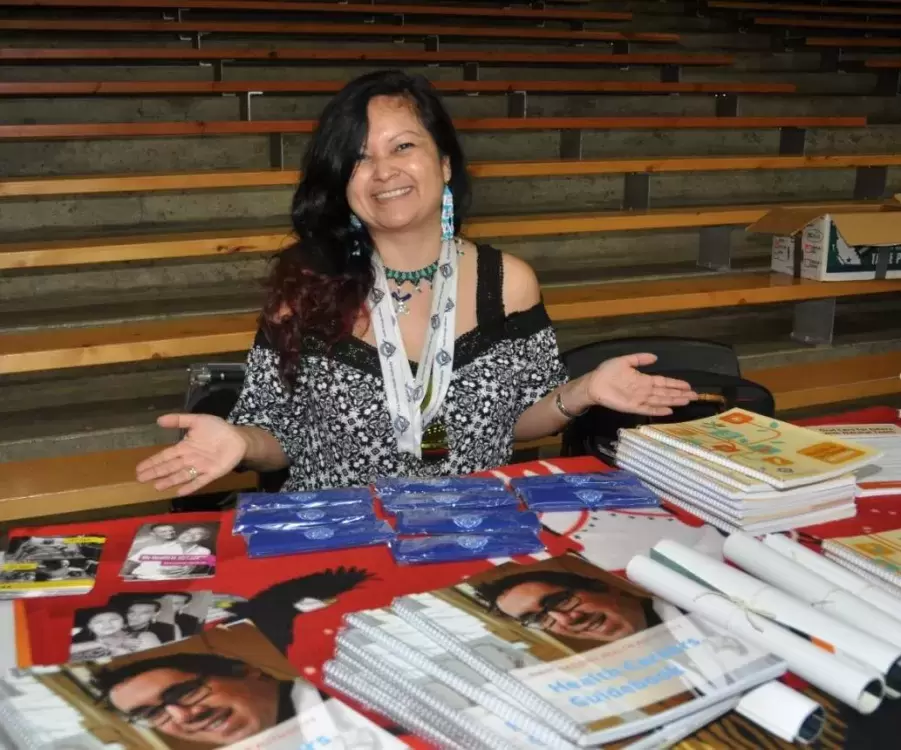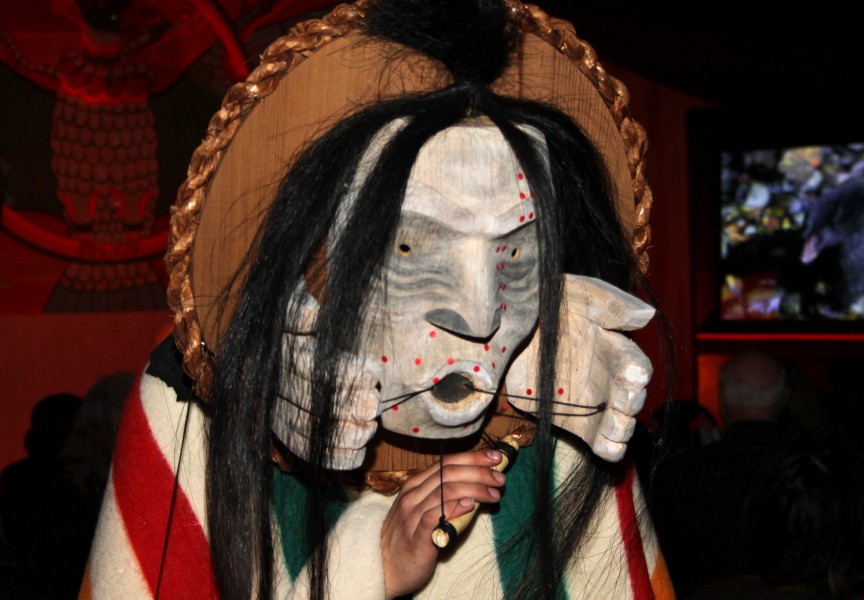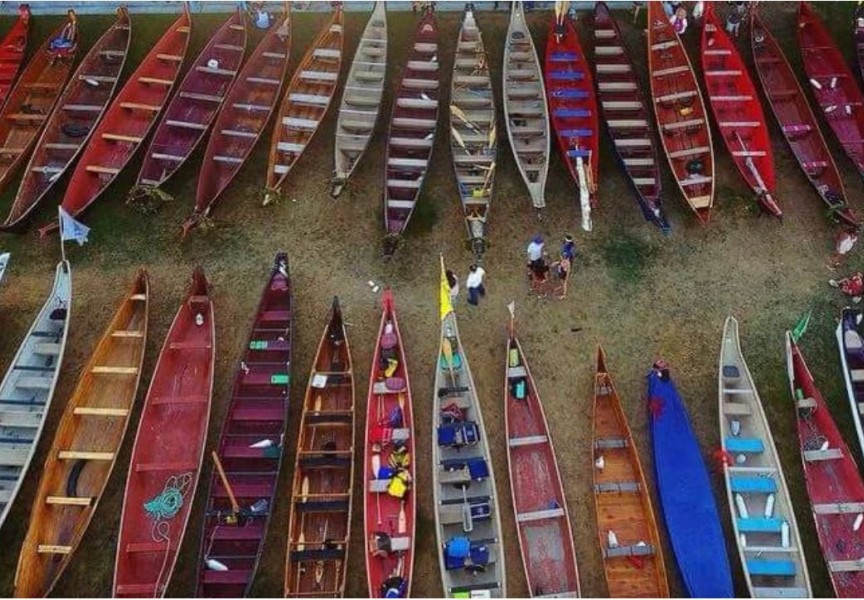The Uchucklesaht Tribe Government celebrated National Aboriginal Day by hosting a Wellness Fair at Alberni Athletic Hall on June 21.
Acting as emcee, Uchucklesaht Ha’wiih Thomas Rush welcomed attendees to the event, which he acknowledged was taking place in the traditional territories of Tseshaht and Hupacasath First Nations.
The opening prayer was delivered by Joe Tom of Quu’asa of the Nuu-chah-nulth Tribal Council’s Mental Health team, followed by two welcoming songs led by Jason Titian, who acknowledged his roots in both Uchucklesaht and Ahousaht.
“It’s really uplifting to be here, to see all the creativeness,” Titian said, indicating all of the assembled tables. “It shows how good and how strong we are as a people. I really value myself today.”
Following the songs, NTC elder statesman Cliff Atleo invited all who knew the Nuu-chah-nulth Song to come forward to sing and to dance.
“This was originally a warrior song, and it came from the head chief of our [Ahousaht] people,” Atleo said.
In the welcoming addresses, Joe Tom said he was deeply moved by the event, and he couldn’t resist a quip.
“It’s an honour to see our people come alive,” he observed, noting the children already at play in the bouncy castles. “When we were kids, it was mudslides.”
But the Wellness Fair had a serious purpose, and a wide range of service providers was on hand to promote their programs.
“We’re here letting people know some of the services we provide,” Quu’asa Wellness Worker Justin Dorward told Ha-Shilth-Sa.
Those range from the traditional to the clinical, he explained, from brushings to clinical counselling and one-on-one support.
“We also provide help for residential school survivors, and we are now looking into answers for the day school scholars. Our team can also help facilitate family healing circles.”
The Quu’asa network extends into the northern, central and southern regions, and once a year conducts an urban gathering in Vancouver.
At the First Nations Health Authority table, Sandra Tate displayed a range of publications the agency puts out, including a wellness guide and an elders guide for B.C.’s Indigenous people. Tate said the fledgling health authority is still evolving.
“What we are doing now is transforming and transitioning from Health Canada into nation-based and community-driven health care services,” Tate said.
In an ongoing community engagement process, FNHA is gathering knowledge and expertise from individual nations across the province to design a custom-built care plan, she explained.
NTC Health Promotion worker Matilda Atleo manned a table featuring a wide range of information that is all geared towards wellness, both physical and spiritual.
“This is what I think about when I think of wellness: all of the knowledge and culture we have to work with,” Atleo said.
That ranges from physical fitness for children to intellectual fitness for adults. On display were a number of language guides created by individual Nuu-chah-nulth Nations over the years, to reflect the regional variations in meaning and pronunciation.
Also on hand was a collection of books by Nuu-chah-nulth authors, ranging from the late George Clutesi to contemporary thinkers like Richard Atleo and Charlotte Cote.
Language revitalization is very much part of the picture for John Rampanen. He was on hand with a number of tools to help both children and adults learn the language of their heritage.
“The idea is to make language learning fun,” Rampanen said. “Especially for adults, it is a challenge.”
Up to a certain age, children absorb sounds and meaning intuitively, he explained. Past a certain age, however, it becomes more of a conscious effort of memorization and repetition.
Rampanen said the goal is to create tools that can be shared by both children and adults as they learn language in their individual ways.
“The tools are to enhance the learning experience. Much of it is hands-on,” he said.
More ambitious is a board game, Quu’as Tiicmis, that is based on traditional Nuu-chah-nulth harvesting practices, working on an annual schedule. Participants hunt and gather traditional food resources as they are available, with the goal of putting together a potlatch feast.
“The game is for up to 26 players, so it can be used in a classroom setting,” Rampanen said.
At a nearby table, Nitanis Desjarlais was surrounded by a gathering of indigenous plants and berries, as well as bags and bowls of dried preparations such as stinging nettle.
“These are a lot of the teas that I have prepared,” she said.
The berries included familiar varieties like the huckleberry and thimbleberry, as well as the less-familiar Pacific crabapple.
“This is the only indigenous apple in all of North America. What we see now was imported,” Desjarlais explained. “These were one of the mainstays of our coastal people.”
Because berries were so critical to the coastal diet, Aboriginal people developed strict protocols and rituals for the gathering of fruit and the maintenance of berry patches.
“And teas made from indigenous plants were a necessity to provide vitamins, especially during the winter when most of the diet was based on protein and fats,” she said.
Gathering fruit is part of the program for Marcus Lobb of the Alberni Valley Transition Town Society.
“We do bike-related stuff like Bike To Work Week and we promote food security,” Lobb said. “We also have the Gleaning Project.”
At harvest time, Lobb explained, homeowners with fruit trees can contact the society to arrange a picking bee.
“The owners get one third, the volunteers get one third and the remainder goes to charity,” Lobb explained.
Youth worker Marla Kjernisted was on hand to represent the Alberni Community and Woman’s Services Society.
“We’re here to promote what we do. We have a lot of services,” Kjernisted said.
Those include the Community-Based Victim Service program as well as support for youth. There is also a drop-in centre operated mainly by volunteers.
“All people are welcome, and we have great participation from the First Nations community,” she said. “We have a Transition House, as well. It’s an emergency shelter for women.
There were also a number of vendors on hand. Pam Watts manned a table of shirts created by her uncle Bob Soderlund. “Ha-Shilth-Sa Bob” split the day between Athletic Hall and the Friendship Centre, which was also hosting an Aboriginal Day event.
Phyllis Halvorsen supervised a table featuring cedar weavings by her daughter Tina.
The snack table arrived early and morphed into lunch in a timely fashion. Attendees had a chance to hear from the various agencies and vendors represented, and both children and adults sat for Story Time with Justin Dorward.







